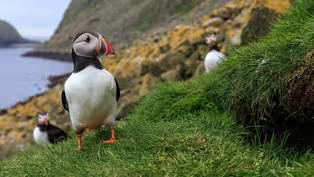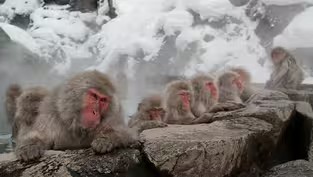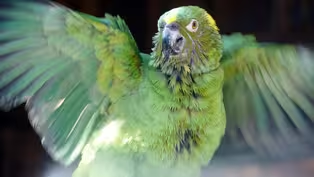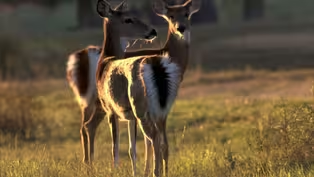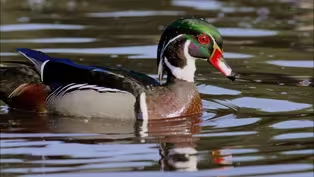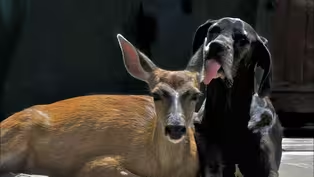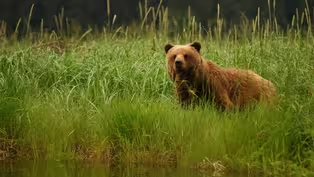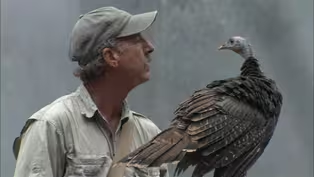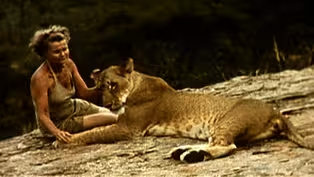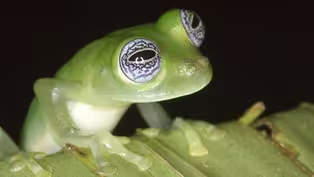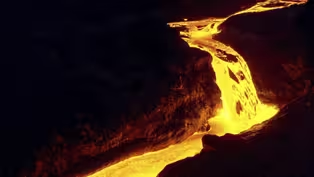
Great Wood of Caledon
Season 9 Episode 6 | 54m 53sVideo has Closed Captions
Emmy-winning filmmaker Hugh Miles presents a lyrical portrait of Scotland's Caledonian For
EMMY AWARD-WINNING FILMMAKER HUGH MILES HAS DEVELOPED THIS PORTRAIT OFONE OF THE GREAT FORESTS OF SCOTLAND -- THE CALDEONIAN FOREST. THIS BEAUTIFUL LYRICAL FILM WAS AWARDED FIRST PRIZE AT THE 1989 MISSOULA FESTIVAL.
Problems playing video? | Closed Captioning Feedback
Problems playing video? | Closed Captioning Feedback
Major support for NATURE is provided by The Arnhold Family in memory of Henry and Clarisse Arnhold, Sue and Edgar Wachenheim III, The Fairweather Foundation, Charles Rosenblum, Kathy Chiao and...

Great Wood of Caledon
Season 9 Episode 6 | 54m 53sVideo has Closed Captions
EMMY AWARD-WINNING FILMMAKER HUGH MILES HAS DEVELOPED THIS PORTRAIT OFONE OF THE GREAT FORESTS OF SCOTLAND -- THE CALDEONIAN FOREST. THIS BEAUTIFUL LYRICAL FILM WAS AWARDED FIRST PRIZE AT THE 1989 MISSOULA FESTIVAL.
Problems playing video? | Closed Captioning Feedback
How to Watch Nature
Nature is available to stream on pbs.org and the free PBS App, available on iPhone, Apple TV, Android TV, Android smartphones, Amazon Fire TV, Amazon Fire Tablet, Roku, Samsung Smart TV, and Vizio.
Buy Now
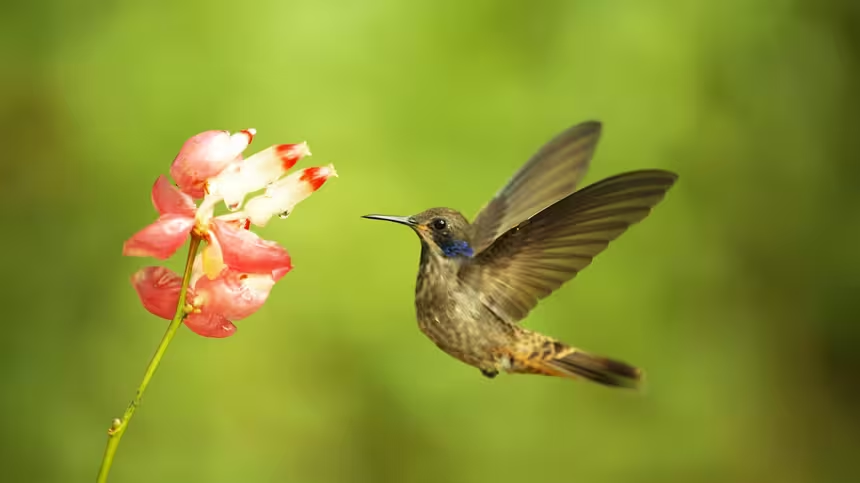
American Spring LIVE
Spring is coming to you LIVE on PBS! Find out how NATURE is celebrating the season of rebirth and how you can get involved as a citizen scientist!Providing Support for PBS.org
Learn Moreabout PBS online sponsorshipMore from This Collection
Watch classic NATURE episodes with the PBS station member benefit Passport.
Video has Closed Captions
Animals congregate in huge colonies partly out of necessity and partly for the security. (52m 55s)
Video has Closed Captions
Follow a troop of snow monkeys in Japan to see how they prepare to face the world. (52m 58s)
Video has Closed Captions
Parrots and the bittersweet world they share with humans. (53m 10s)
Video has Closed Captions
Learning about one of our closest neighbors: the white-tailed deer. (53m 10s)
Video has Closed Captions
Take a fascinating look at one of our most familiar birds. (1h 42s)
Video has Closed Captions
Love apparently knows no boundaries in the animal kingdom. (53m 20s)
Video has Closed Captions
Enter a world shaped by bears, trees, and salmon. (50m 9s)
Video has Closed Captions
One man's remarkable experience of raising a group of wild turkey hatchlings to adulthood. (58m 51s)
Elsa's Legacy: The Born Free Story
Video has Closed Captions
The true story that inspired "Born Free". (53m 10s)
Video has Closed Captions
It is the greatest mass extinction since the dinosaurs. (53m 43s)
Video has Closed Captions
Kilauea, on Hawaii's Big Island, is the world's most active volcano. (54m 6s)
Video has Closed Captions
Relationships with cats and dogs are some of the longest and most intimate of our lives. (53m 30s)
Providing Support for PBS.org
Learn Moreabout PBS online sponsorship[soft music] [birds chirping] [soft music] [birds chirping] [water rushing] [soft music] [soft music] [soft music] - The forest has no real secrets, just stories and treasures hidden from the untrained eye.
Hi, I'm George Page.
For most of us, a walk in the woods is refreshing, good exercise and a special time with nature.
Yet even though there are living communities all around us here, sometimes we truly can't see the forest for the trees.
For others, those with patience, skill, and experience, this walk is a journey into a fascinating society of forest life.
Hugh Miles is an artist with a camera working in his native Scotland, he has created a very special, very personal film, about one of the wildest areas left in western Europe.
The ancient Caledonian pine forest contains trees that are centuries old and provides a refuge for creatures like the Scottish Wildcat.
These precious remnants of the huge forests that once blanketed Europe, now occupy only a tiny fraction of their original range.
Hugh Miles has captured these great forests for all time in his award-winning film.
[wind rustling] The Highlands of Scotland, one of the wildest and most precious parts of Western Europe, a vast area of hill and forest, which the Romans called Caledonia.
Even today, these wild woods are the largest tracks of old forest in Britain.
It's February in these ancient woodlands and the Scottish Crossbill are preparing to breed.
Only recently was it discovered that they are unique, the only bird species found in Britain and nowhere else.
The females plumage is a very different color from that of the orange red male.
She has to be well camouflaged while sitting on the nest, which she builds out of pine twigs and lines with a carpet of dry grass, sheep wool, and feathers.
[wind rustles] [wind rustles] [birds chirps] Scottish Crossbills are confined almost entirely to these ancient pine forests.
At one time they must have been very common, for once the trees grew over most of the highlands.
But long before that, this land looked very different.
During the ice age, enormous ice caps buried these hills and glens.
Then about 10,000 years ago the ice melted, exposing vast areas of land, which eventually would become blanketed with forests.
The first trees to colonize this land were birch and hazel.
Later, some 6,000 years ago, Scott's pine became the dominant tree and for centuries the great wood of Caledon was a haven for wild creatures.
But Scotland's untamed spirit still lingers here, haunting this primeval forest.
[wolf howls] Wolves, lynx, wild boar, and brown bears once walked below these wooden towers.
Even today, one descendant of these wildest of animals still remains, the Scottish Wildcat.
A great hunter of grouse and tonegen, this cat suffered years of persecution from gamekeepers, but wary and elusive, it has survived.
Most of the other large mammals have been killed by humans or were driven out as the forests were cut down, mainly for timber.
[tree falls] [chainsaw buzzing] [trees falling] These great pines once covered this enormous area in northern Scotland.
Centuries of ax, saw, and fire have reduced the forest to less than 1% of its natural range.
Now, only a few remnants are left, but even so there are still magnificent Scott's pines and some of them, like this great veteran, are more than 300 years old.
[birds chirping] These trees provide a home for some fascinating wildlife, but no creature depends more on the Scott's pine than the Scottish Crossbill.
For its staple diet is pine seeds.
They're so reliant on them that even their anatomy has become adapted.
They have an extra large crossed bill for opening the tough cones and a long tongue to extract the seeds.
[birds chirping] But crossbills give something back to the forest.
They're picky eaters and by discarding many seeds and cones, they help the tree to reproduce.
[pinecone falls] [birds chirping] Wood ants also live in partnership with the tree, using discarded pine needles to build their nests.
They're shaped and positioned to face south, so the sun can warm up the colony.
By constantly altering the shape of the thatched roof, the workers are able to regulate temperature in the network of tunnels, a critical element for successful breeding.
In some colonies, there are half a million wood ants, with many nests three feet high, they're like cities.
The ants help trees by eating harmful insect pests, and they have to wander some distance to supply the nest with food.
All this activity may look chaotic.
In fact, it's a highly organized society.
These tiny specs among the giant trees find their way using a scent trail and each ant knows exactly where it's going for the next meal.
But there are insects and then there are insects.
The remarkable Timberman lives only in Scottish Woods.
It seeks dead or dying timber in which to lay its eggs.
Scott's pine trees, even dead ones, are essential to the survival of many creatures, such as the highly specialized Crested Tit.
[birds chirping] In Britain, it's confined exclusively to the pine woods of the Scottish highlands, and is now being studied to find out why it's so restricted.
Individuals are banded and their behavior is recorded.
Mid-April, the birds must find a dead pine soft enough for excavating a nest.
[bird wings flutter] By late April, the forest resounds with a tapping of many specialized beaks.
[birds chirping] [wings flapping] When dawn breaks the chorus is a especially vibrant.
[birds tapping] [birds tapping] [birds tapping] The magnificent courtship display of the world's largest grouse, the capercaillie.
It's an ancient ritual for attracting females to mate.
The turkey sized males strut around and show off in a traditional spring dance of the great woods.
These display sites called leks are used by several males, which gather to contest the right to mate.
The flamboyant posturing is a show, often it averts violence, but when fights do occur, they can lead to death.
[wings flapping] [wings flapping] [wings flapping] [birds squawking] These colorful performances attract the hens whose duller plumage will later provide camouflage on the nest.
Many females will offer themselves to the dominant males for mating.
[bird squawking] Competing cocks attempt to mate with the hens and must be chased off.
It's only the dominant that mates with most of the hens, ensuring the fittest offspring.
[birds chirping] The female will now spend several weeks building a nest and laying her eggs.
She usually nests below a tree, a very convenient food source.
[birds chirping] Pine needles have sustained both the male and female during the winter, but as spring approaches, they'll soon have many other plants to eat.
[birds chirping] The capercaillie is one of the great specialists of the pine forest, but there's another grouse that also lives here, a bird of the forest edge, the black grouse.
[birds cooing] Embarking on their own traditional ritual, courtship reaches its height in early May.
Again, it's the male that must attract the female with a display that's just as grand as the capercaillie's.
[birds cooing] [birds cooing] [birds cooing] Out in the open and absorbed by one another's posturing, they're vulnerable to predators, and some of them are large and powerful.
The golden eagle, one of the strongest birds of prey, is often found on the mountain tops and moors, but it's equally at home in the Caledonian pine forest.
The grand old trees provide towering nest sites, some of which have been used on and off for more than a century.
This continuous use can result in nests 15 feet tall.
It's now early May, and this pair has chicks to feed, so the male must increase his hunting.
[wind rustling] He'll fly far out over the forest and up into the hills, searching the ground for mountain hares, grouse, tonegen, and even an occasional fox cub.
But he also hunts in the more open forest, catching rabbits, crows, and sometimes snatching red squirrels as they dash from tree to tree.
[wind rustling] He brings the food to the nest and tears it up for the young chick, which is about two weeks old.
[birds chirping] A red squirrel provides a hearty meal, but it's just enough for this ravenous youngster.
[birds chirping] This large and formidable predator is an amazingly gentle parent, feeding the chick with grace and delicacy.
[wings flapping] As the chick grows, the adults break off greenery to take back to the nest.
This camouflages the bare surroundings.
Through the centuries, the only real threat to eagles has been man.
[wings flapping] Once all predators were seen as a threat, and many eagles were killed, along with wolves, bears, and lynx.
The last wolf was killed in 1743 and by then most of the forests had been destroyed too.
[birds chirping] For Scottish Crossbills, it was the felling of the trees which reduced their numbers so severely.
Since they live nowhere else, they're now one of the rarest birds in Europe.
[birds chirping] Their breeding has to coincide with the season when pine seeds are at their biggest, best, and most accessible.
The male feeds the chicks and hen by regurgitating a pine meal porridge.
[birds chirping] [birds chirping] Seed crops vary considerably, so Scottish Crossbills need large areas of forest to search for food, if they're to breed successfully.
Remove the trees and they could become extinct.
But their survival has always been a struggle.
Despite camouflaging their nests and dense foliage near the ends of high branches, crossbills are vulnerable to predators.
[birds chirping] Red squirrels, for example, spend a lot of time searching for birds' nests and if found, they eat both eggs and young.
[birds chirping] But the red squirrels themselves are hunted.
Pine Martens are opportunists.
They will eat almost anything.
They scour the forest for food, licking something as tiny as aphids off a pine branch, or pursuing squirrels through the trees and vols on the forest floor.
[birds chirping] [birds chirping] Pine Martens climb trees easily searching out bird nests.
In this case, however, the marten found some beetle grubs.
[birds chirping] Hunting almost exterminated Pine Martens, but their numbers are recovering and once again, they're widespread in the western highlands.
They are even recolonizing the eastern forests, where they prey on the red squirrels, which abound here.
Youngsters like this are easy prey for martens.
This one is only two weeks out of the nest and still confined to exploring nearby branches.
[birds chirping] [birds chirping] Several families can have nests in each home area and the youngsters will return to them frequently.
They may be secure refuges, but they're also flea infested.
[birds chirping] Red squirrels eat a lot of pine cones, but this youngster has taken a liking to the twigs.
[birds chirping] They'll also venture to the forest floor to feed on fallen seeds and cones, but this one still needs his mother's watchful eye.
She fiercely defends their food supply from strangers.
Red squirrels were ousted from the southern oak and hazelwoods by the gray squirrel, the same species found in our North American woods.
So today it's the great wood of Caledon that provides a last safe refuge for this delightful creature.
[birds chirping] It's now late May in the ancient pine forests of Scotland, a time when reproduction is at its peak, even for the Scott's Pine tree itself.
[birds chirping] The tree's male flowers are bursting with pollen and on fine warm days, gusts of wind blow it over the branches, fertilizing the little red female flowers in a creative blizzard.
[birds chirping] In one year's time, these red flowers will grow into green cones.
In two years, they will ripen to sprinkle dozens of seeds, a few of which may germinate to produce new trees.
Those in open spaces do best and in time a few may even grow to replace the ancestral pines, many of which are more than 200 years old.
[birds chirping] [wind rustling] Although they appear to be solid pillars of strength, when they've grown to maturity these old giants can suffer attacks from insects.
One of their worst enemies is the caterpillar of the Pine Beauty moth, which is attacked in turn by the wood ants.
The caterpillar's defense is to simply drop off the tree, but when the ants close in, the end is inevitable.
[birds chirping] [birds chirping] The workers subdue the struggling caterpillar with brute strength.
Then they spray the victim with formic acid to immobilize it and drag it back to their nest for food.
[birds chirping] And in another nest, it's also feeding time.
Crested Tits now have well grown young, as do many other species of the forest, and the demand for food in the great wood is at its peak.
There are four to five youngsters in a brood and their diet consists of caterpillars, spiders, moss, mosquitoes, and even pine cone seeds.
Housekeeping in the small nest is important and the hen removes all droppings.
Crows, Pined Martens, and red squirrels are always a threat and the chicks stay silent when their mother is absent.
[birds quietly rustling] The sooner the large chicks leave the nest, the better.
So when they're about two weeks old, the female perches close by with food and tempts them out.
[birds chirping] This must be a daunting time for chicks that have never been in the outside world before, but it's even more difficult for the adults.
They know the chicks must be led away from this exposed spot as soon as possible.
[birds chirping] [birds chirping] [birds chirping] Once away from the nest, the chicks are encouraged to scramble up into the safety of the denser branches.
[birds chirping] Each adult looks after a different group of chicks.
The chicks separate to avoid detection by predators.
Sparrowhawks time their breeding to coincide with an abundance of readily available food.
The fledglings are easy prey for them.
[birds chirping] With the female guarding the recently hatched young, it's the male that catches and then plucks the prey.
[bird calling] He does this within earshot of the female and calls her off the nest for the exchange of food.
[bird calling] [wings flapping] The size and survival of the brood depend a lot on how well the smaller birds breed.
The siskins, crested tits, cold tits and others.
If these birds raise plenty of young, the sparrowhawk chicks will survive.
[birds chirping] But the Caledonian pine forest has a smaller choice of prey and less of it than other woodlands.
So sparrowhawks here breed at lower densities than anywhere else in the country and each family needs a big area of forest as a hunting domain.
[birds chirping] Some territories range from the dense forest, where the hawks nest right up into the hills at 2000 feet, where only a few trees will grow.
[water rushing] Up here the ancient pines provide nest sites for a strange looking bird.
The common merganser is a specialized duck, which eats fish.
It has a long saw edged bill, a streamlined body, and large powerful webbed feet.
This female's eggs have just hatched.
She now has to encourage her day old ducklings to jump down from the security of their hollow branch and then negotiate these waterfalls and rapids.
[water rushing] Her orange feet suggest she's only two years old, so this might well be the first time she's raised young.
She seems anxious at the prospect of the unknown ordeal ahead.
[wings flapping] [water rushing] [ducklings chirping] [water rushing] [ducklings chirping] [water rushing] For her ducklings to survive she must lead them quickly downstream through the white water.
[ducklings chirping] [water rushing] [ducklings chirping] [water rushing] [water rushing] [water rushing] [water rushing] [water rushing] [water rushing] [water rushing] The ducklings head downstream to the bigger streams and rivers of the forest, where they'll find an abundance of tiny trout, salmon, and minnows to eat.
[birds chirping] It's now mid-summer and the great wood rings to the songs of many birds.
[water splashing] [birds chirping] The locks and the riverside team with insects, food for fish and birds alike, and deep in the forest, the ground sprouts carpets of flowers that thrive in association with Scott's Pines.
There are cow bees, blackberries, crowberries, and heather.
[bee buzzing] Wood anemones bloom here in profusion and specialist orchids like creeping ladies dresses and the lesser twayblade reach up shyly to the sun.
[birds chirping] The delicate twin flower, a real pine specialist, spreads its fragile delight across the forest floor, and in the wetter areas, bog asphodel splashes it with color.
[wind rushing] [wind rushing] Juniper Bush's flower and fruit, providing not just food, but secure nest sites for vulnerable birds.
[birds chirping] The hen capercaillie's camouflage and immobility help ensure that her nest isn't found by foxes and other predators during her four week incubation.
But now that her chicks have hatched, they must be led away from the nest to feed.
Their first foods are insects and leaves of plants, especially blackberry.
The pine forest with its rich ground flora will provide these hungry chicks with the nutritious diet they need.
[birds chirping] As with most ground nesting birds, the chicks are mobile the day they hatch, but it's this very movement that attracts the attention of predators.
[birds chirping] Scottish wildcat may look like ordinary house cats, but they're actually quite aggressive and formidable predators of the great wood.
They hunt largely at night, but on warm days they like to pan around and sunbathe.
[birds chirping] But if it comes across unwary prey during the day, such as capercaillie chicks or a careless rodent, it won't ignore the chance for a meal.
[bird chirping] [birds chirping] [birds chirping] A far greater danger to caper chicks is poor weather.
They easily become wet and cold in the dense vegetation and die.
[thunder and rain falling] The capercaillie population has declined greatly in the 1980s, years with cold wet weather during the critical week after the chick's hatch.
A prolonged wet climate can even endanger the forest itself.
Waterlogged ground deters regeneration and kills trees.
Indeed, two and a half thousand years ago, a wet climate destroyed huge areas of forest and all that remains of those great pines is their skeletons, buried in suffocating peat.
But water does have a good side.
It settles in hollows left by the receding ice age.
These forest ponds are important feeding areas for several special birds.
[water splashes] [birds chirping] Recently, golden eye from Scandinavia have colonized the Scottish highlands, nesting in dead hollow trees and raising their young on the rich insect life of the shallow waters.
Broods of 10 or more are normal, but can number up to 18.
[water splashing] [birds chirping] The chicks soon learn to dive for food, just as their mother does.
She looks after her brood and shepherds them into cover, if a predatory bird moves overhead.
Ospreys are no threat to the ducklings, for they live almost exclusively on live fish.
The forest ponds hold many pike, trout, and eels, and on some days fishing is spectacular.
[wings flapping] [birds calling] [birds chirping] [water splashes] He's got a trout which he'll bring to the nest for his mate and young.
[wings flapping] [birds chirping] Since Osprey's returned to Scotland from Scandinavia in the early fifties, their numbers have increased greatly.
This nest is just one of more than 50, which are occupied now.
[birds chirping] [birds chirping] The chicks are six weeks old and are just 2 of about 70 young, which are raised in Scotland each year.
Ospreys have been well protected by the Royal Society for the Protection of Birds and also by enlightened landowners.
The numerous nests in the forest have ensured that the return of the Osprey will remain a great success story.
[birds chirping] Within a couple of weeks, these two chicks will fly over the great wood for the first time, exercising inexperienced wings in preparation for their long flight to Africa where they spend the winter.
Below, the wood ants will also be reaching the end of their breeding year, but they have an enemy to contend with, lurking on branches near the nest.
This isn't a ladybug, but a female clitra beetle, and she has a clever way of penetrating the defenses of the wood ants nest.
After laying an egg, she camouflages and protects it from ant attack by covering it with scales and it ends up looking like a miniature pine cone.
[birds chirping] Then she drops her egg near the wood ant's nest and it proves irresistible, possibly because of a chemical attractant.
Within minutes, the enemy's egg is carried into the nest and laid down alongside the ant's eggs.
[ants scurrying] Inside the nest, ant reproduction is reaching its peak.
Many workers attend the queen and guard her eggs, the colony's future, but lying beside them, the clitra egg hatches into a carnivorous grub, protected from ant attack by a hardened case, which it fashions from nest debris.
From inside its mobile fortress, it preys on the wood ant's larva and cocoons, until a year after the egg was laid, it leaves the nest as an adult beetle to start the parasite cycle all over again.
But beetles have enemies too.
[tapping on wood] Great spotted woodpeckers clean trees of insect pests.
The pines in return provide nest sites for their next generation.
[tapping on wood] [birds chirping] The youngsters are curious about the outside world and with the adults hunting so close to the nest, the chicks will learn their parents' wood boring techniques.
[tapping on wood] These nest holes are in high demand and the swifts are prospecting for next year.
Swifts normally wait until nests have been vacated, but with the season well advanced, this one is over eager.
[birds chirping] Great spotted woodpeckers are one of the last birds to fledge their young.
The coming of shorter days and colder nights signals that summer is over.
[birds chirping] [birds chirping] It's autumn, numerous fungi burst out of the ground.
Many species live in association with the root tips of the Scott's Pine or on their fallen limbs.
Others live on the birches that fringe the forest and the locks.
By October, the ancient woods begin to change.
The air becomes crisp and the days grow short.
For some, this means preparations must begin for the coming winter.
This red squirrel will be ready, during the summer he's been stashing away fungi for the winter.
On autumn days, they spend their time carefully checking these well hidden supplies and eating to build up fat reserves.
[birds calling] As the first snow powders the surrounding hills, gray lag geese arrive from Iceland, driven out by the Arctic chill.
[birds calling] Forest locks provide safe roosts and the geese will return nightly after feeding in the local fields.
[birds calling] The coming of the geese heralds the coming of winter.
With winter comes one of the most serious threats to the Caledonian pine forest's red deer.
Driven off the hills by harsh weather, they seek food and shelter in the woods and eat the young trees, but damage isn't confined just to the winter because of reduced forests, and a doubling of dear numbers in the last 100 years, in many areas, there are no young trees at all.
With so little chance for regeneration, the remnants of the great wood of Caledon could be lost forever.
[snow crunching] Fortunately, a few patches of forest still remain, protected by sympathetic landowners, conservation organizations and new forestry policies.
[birds chirping] [snow crunching] Glen Afrik, Glen Tanner, Balak Bowie, Abernethy, Rothley Marcus.
These are some of the forests that have survived.
[wind rushing] This great wood is unique, a spectacular monument to an ancestral Caledonia, a priceless part of Scotland's living Heritage.
[birds chirping]

- Science and Nature

Explore scientific discoveries on television's most acclaimed science documentary series.













Support for PBS provided by:
Major support for NATURE is provided by The Arnhold Family in memory of Henry and Clarisse Arnhold, Sue and Edgar Wachenheim III, The Fairweather Foundation, Charles Rosenblum, Kathy Chiao and...
